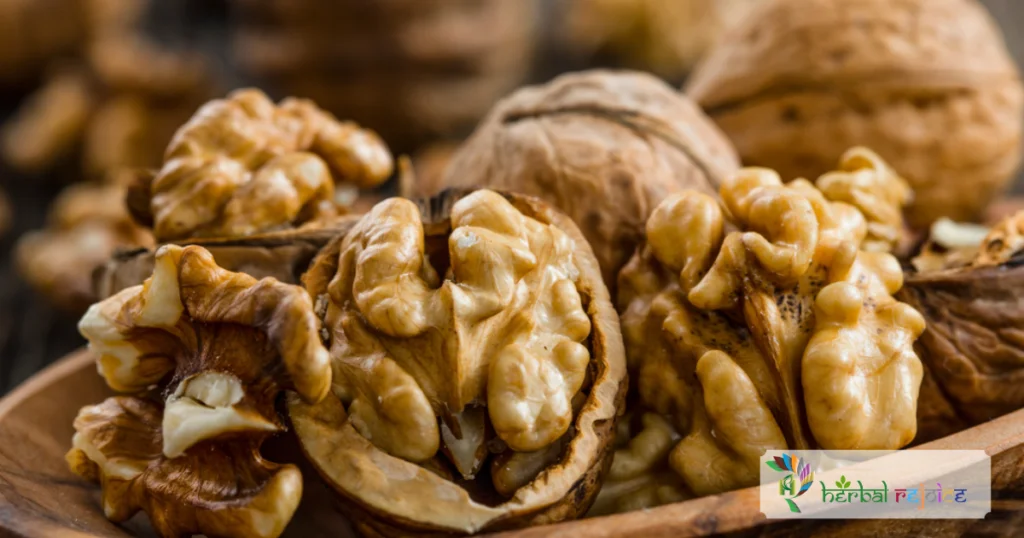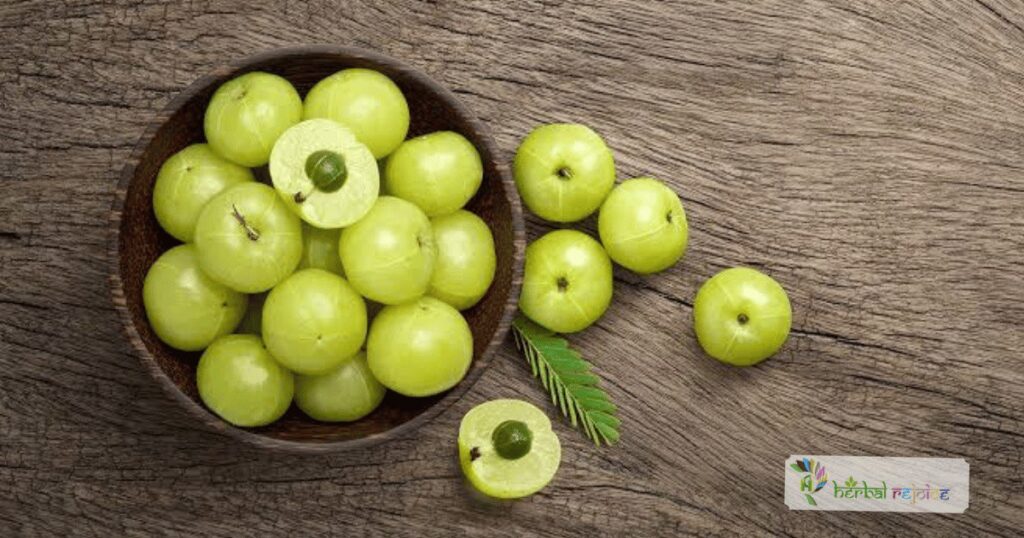Introduction To Walnut
Walnut, scientifically known as Juglans regia Linn., is a member of the Juglandaceae family. Known for its numerous health benefits, the English Walnut has been used in Ayurvedic, Unani, and Siddha/Tamil traditions for centuries.
Walnut acts as alterative, laxative, antiseptic, mild hypoglycemic, anti-inflammatory, antiscrofula, and detergent agents. Infusions of the leaves and bark are commonly used to treat herpes, eczema, and other skin conditions.
It can also be applied externally to skin eruptions and ulcers. The volatile oil derived from the tree exhibits antifungal and antimicrobial properties.
Names And Habitat Of Walnut
In Ayurvedic medicine, the English Walnut tree is known by several names such as Akshoda, Akshodaka, Akshota, Shailbhava, Pilu, Karparaal, and Vrantphala. Unani medicine refers to it as Akhrot, while in Siddha/Tamil, it is called Akrottu. Although native to Iran, it is now cultivated in various regions including Kashmir, Himachal Pradesh, Khasi Hills, and the hills of Uttar Pradesh.
Chemical Constituents Of Walnut
The volatile oil derived from English Walnut leaves contains several terpenoid substances such as monoterpenes, sesquiterpenes, diterpene, and triterpene derivatives.
It also contains eugenol and various fatty acids including geranic acid, alpha-and beta-pinene, 1,8-cincole, limonene, beta-eudesmol, and juglone.
The leaves of the English Walnut tree contain naphthoquinones, primarily juglone.
The root bark contains 3, 3,-bis-juglone and oligomeric juglones.
Napthoquinones are also present in the unripe fruit husk.
Traditional Applications Of Walnut
The leaves and bark of the English Walnut tree have various medicinal properties.
One key application of the English Walnut tree is in the treatment of mild, superficial inflammation of the skin and excessive perspiration of hands and feet.
According to the German Commission E., this treatment has shown effective results.
Additionally, incorporating English Walnuts (Juglans regia) into a low-fat diet can help reduce total cholesterol levels by 4-12% and LDL by 8-16%, as reported by the Natural Medicines Comprehensive Database in 2007.
Walnut hull preparations have been traditionally used for treating skin diseases and abscesses. In addition to its medicinal uses, walnuts are also consumed as a dry fruit.
The resemblance of walnuts to the brain led to the belief, based on the “doctrine of signatures,” that they act as a good brain tonic. People also eat walnuts to lower their cholesterol levels.

Key Components Of Walnut
The kernels of Indian walnuts are a rich source of nutrients. They contain 15.6% protein, 11% carbohydrates, and 1.8% mineral matter, including sodium, potassium, calcium, magnesium, iron, copper, phosphorus, sulfur, and chlorine.
They also contain trace amounts of iodine, arsenic, zinc, cobalt, and manganese. Furthermore, the kernels are abundant in vitamins of the B group, vitamin A, and ascorbic acid.
Potential Health Benefits Of Walnut
It is worth mentioning that the juice of unripe English walnuts has shown significant thyroid hormone enhancing activity. Walnut hull preparations have been traditionally used for treating skin diseases and abscesses.
In addition to its medicinal uses, walnuts are also consumed as a dry fruit. The resemblance of walnuts to the brain led to the belief, based on the “doctrine of signatures,” that they act as a good brain tonic.
People also eat walnuts to lower their cholesterol levels. However, prolonged use of such extract may lead to serious side effects.
Juglans cineraria Vs Juglans regia
Juglans cineraria L., known as White Walnut, Lemon Walnut, Butternut, or Oilnut in the USA, should not be confused with Juglans regia.
The inner bark of Juglans cineraria contains napthoquinones, including juglone, juglandin, and juglandic acid. It also contains tannins and an essential oil. This species is commonly used as a dermatological and anti-hemorrhoidal agent.
Juglone, found in Juglans cineraria, exhibits antimicrobial, antiparasitic, and antineoplastic activities.
Dosage Of Walnut
In terms of dosage, dried cotyledons of the English Walnut tree are typically consumed between 10-25 grams.
Conclusion
In conclusion, the English Walnut tree (Juglans regia Linn.) is a remarkable plant with numerous health benefits. It has been used in traditional medicine for its alterative, laxative, antiseptic, and anti-inflammatory properties
. Incorporating walnuts into a low-fat diet can help lower cholesterol levels. However, it is important to differentiate between Juglans regia and Juglans cineraria, as their properties may vary.
With its rich nutritional profile and medicinal properties, it is evident why the English Walnut tree is highly regarded in various medicinal traditions.
Frequently Asked Questions(FAQs)
What is the scientific name of the English Walnut tree?
The scientific name of the English Walnut tree is Juglans regia Linn.
Where is the English Walnut tree native to?
The English Walnut tree is native to Iran.
What regions is the English Walnut tree cultivated in?
The English Walnut tree is cultivated in regions such as Kashmir, Himachal Pradesh, Khasi Hills, and the hills of Uttar Pradesh.
What are the medicinal properties of the leaves and bark of the English Walnut tree?
The leaves and bark of the English Walnut tree have medicinal properties, including acting as alterative, laxative, antiseptic, mild hypoglycemic, anti-inflammatory, antiscrofula, and detergent agents.
What conditions can be treated with infusions of English Walnut tree leaves and bark?
Infusions of English Walnut tree leaves and bark can be used to treat herpes, eczema, and other skin conditions.
What are some external applications of the English Walnut tree?
The volatile oil derived from the English Walnut tree can be applied externally to treat skin eruptions and ulcers due to its antifungal and antimicrobial properties.
How can English Walnuts reduce cholesterol levels?
Incorporating English Walnuts into a low-fat diet can help reduce total cholesterol levels by 4-12% and LDL by 8-16%.
What traditional use do walnut hull preparations have?
Walnut hull preparations have traditionally been used for treating skin diseases and abscesses.
Why are walnuts considered a brain tonic?
Based on the “doctrine of signatures,” walnuts, which resemble the brain, are believed to act as a good brain tonic.
What compounds are present in the volatile oil derived from English Walnut leaves?
The volatile oil derived from English Walnut leaves contains terpenoid substances such as monoterpenes, sesquiterpenes, diterpene, and triterpene derivatives. It also contains eugenol and various fatty acids.
What chemical compounds exist in the leaves and root bark of the English Walnut tree?
The leaves of the English Walnut tree contain naphthoquinones, primarily juglone, while the root bark contains 3, 3,-bis-juglone and oligomeric juglones.
What nutrients are present in the kernels of the English Walnut tree?
The kernels of the English Walnut tree contain protein, carbohydrates, minerals (such as sodium, potassium, calcium, magnesium, iron, copper, phosphorus, sulfur, and chlorine), and small amounts of iodine, arsenic, zinc, cobalt, and manganese. They are also rich in vitamins B group, vitamin A, and ascorbic acid.
What does the juice of unripe English walnuts do?
The juice of unripe English walnuts has significant thyroid hormone enhancing activity.
What potential side effects can come from prolonged use of unripe English walnut extract?
Prolonged use of unripe English walnut extract may lead to serious side effects.
How does Juglans cineraria differ from Juglans regia?
Juglans cineraria, also known as White Walnut, Lemon Walnut, Butternut, or Oilnut, should not be confused with Juglans regia. They have different properties, and Juglans cineraria is commonly used as a dermatological and anti-hemorrhoidal agent.
What compounds can be found in the inner bark of Juglans cineraria?
The inner bark of Juglans cineraria contains napthoquinones, including juglone, juglandin, and juglandic acid. It also contains tannins and an essential oil.
What is the recommended dosage of dried cotyledons of the English Walnut tree?
The recommended dosage of dried cotyledons of the English Walnut tree is typically between 10-25 grams.
What are the key benefits of the English Walnut tree?
The English Walnut tree has numerous health benefits, including being alterative, laxative, antiseptic, and anti-inflammatory.
What regions are known for their cultivation of the English Walnut tree?
Regions such as Kashmir, Himachal Pradesh, Khasi Hills, and the hills of Uttar Pradesh are known for cultivating the English Walnut tree.


